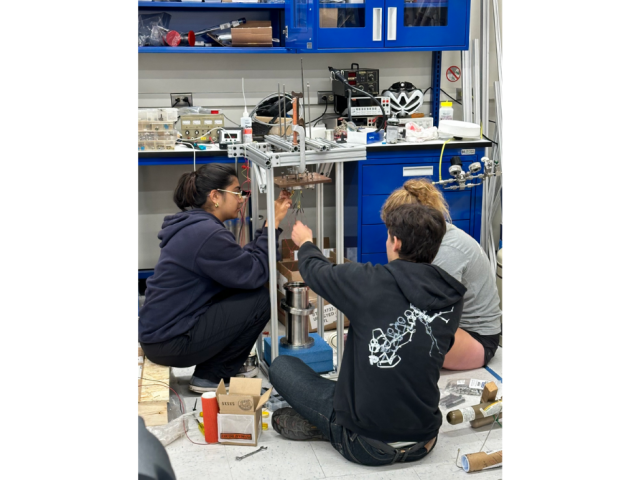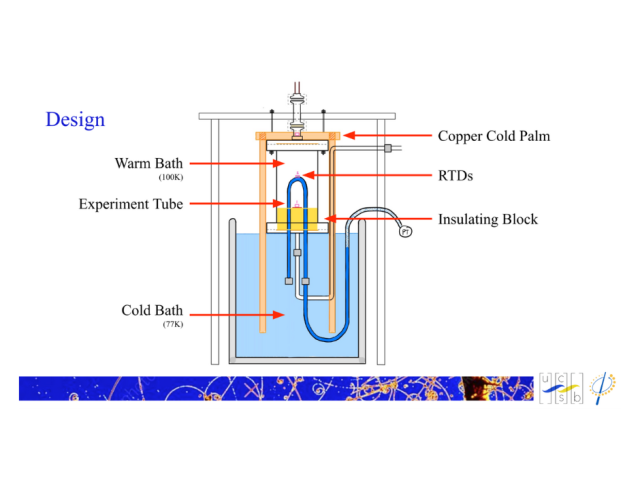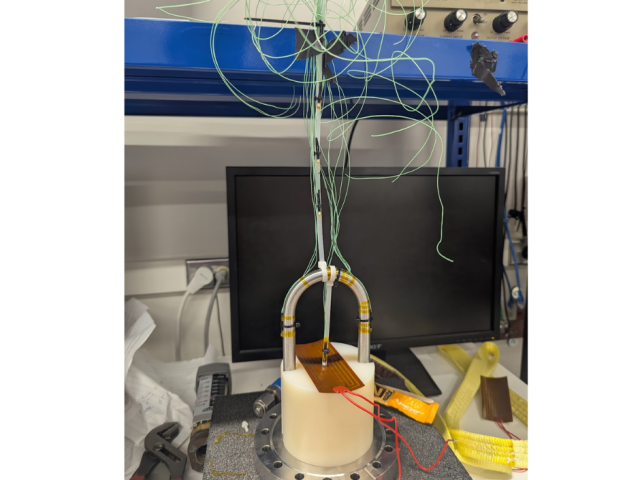Undergraduates Seek to Illuminate the Dark Side of Physics
Janhavi Singhal ’26 (CCS Physics) and Haley Fogg ’26 (L&S Physics) push the boundaries of dark matter research in the Lippincott Lab at UCSB

Janhavi Singhal ’26 (CCS Physics) and Haley Fogg ’26 (L&S Physics) have become captivated by the "dark side" of physics: detecting elusive dark matter. Their collaboration started in a CCS and L&S honors lab course with Jack Kingdon (L&S Physics) and has evolved into a quest to illuminate this cosmic mystery.
“There’s just this huge chunk of our universe—about 27%—that’s dark matter, and we’ve never actually seen it or detected it,” said Janhavi. “We just know it’s there from gravitational effects. That’s what makes it so interesting. It’s one of the biggest mysteries in physics."

Janhavi and Haley are part of the Lippincott Lab, led by Department of Physics Faculty Dr. Hugh Lippincott. The lab focuses on the direct detection of dark matter, with three active projects. Janhavi and Haley’s is notable for two reasons: it is a completely undergraduate-led effort, and they're building a bubble chamber from the ground up.
“We’re trying to create a detector that’s sensitive enough to pick up the really rare interactions of dark matter with known matter,” explained Haley.
Bubble chambers were invented in the 1960s with the original use of detecting and studying the paths of high-energy particles. Now, bubble chambers are used in a different experimental configuration as dark matter detectors. Their unique advantage in the search for dark matter is their ability to exclude background noise caused by other particles that would typically appear in other dark matter detectors, which allows scientists to get a cleaner signal. Bubble chambers use a liquid heated just below its boiling point. When an energetic particle, like dark matter, hits a nucleus in the liquid, it releases enough energy to form a bubble. By carefully adjusting the liquid’s temperature and pressure, the detector ignores lower-energy collisions from unwanted radiation sources, like gamma rays and cosmic rays. This makes bubble chambers especially useful for spotting the rare signals that could point to dark matter.

The project draws on previous work at the Dahl Lab at Northwestern University, which set down a preliminary design for an all-metal bubble chamber. By building on these studies, Janhavi and Haley are hoping to test the chamber’s sensitivity and performance.
Janhavi, who previously interned at national labs including SLAC National Accelerator Laboratory and Lawrence Berkeley National Laboratory (LBNL), is now focused on optimizing the chamber’s capabilities. “I’m working on making the bubble chamber as sensitive as possible,” she said. “It’s a really cool piece of technology, and it’s exciting to be part of something that could help answer big questions."

For both students, contributing to meaningful research as undergraduates has been a defining part of their UCSB experience. “It’s crazy to think we’re working on something that might help detect dark matter—as undergrads,” said Haley. “It’s the coolest thing I’ve done in college so far. I feel like I’m part of something that really matters.” The hands-on nature of the project has also shaped her goals: “It’s made me want to do more research long-term.”
“I love fundamental physics questions,” added Janhavi. “Dark matter is such a huge one, and it’s astounding that we’re trying to detect something invisible.”
From a curiosity-driven standpoint, dark matter research helps answer key cosmological questions—how galaxies form, why mass is distributed as it is, and how the universe is evolving. “Even failure is progress—it sharpens what dark matter can’t be,” Janhavi noted. The work also drives innovation in detector physics, including cryogenic technology and instrumentation, with applications across many fields of science and industry.
Both students plan to pursue doctoral degrees in physics with an emphasis on high-energy physics or astronomy–interests shaped in large part by their practical experience in the Lippincott Lab. They emphasized their enjoyment of the physical and technical aspects of the work, from welding to troubleshooting experimental setups, and see dark matter research as a fulfilling long-term career path.
The College applauds Janhavi and Haley for their initiative, collaboration, and commitment to pushing the boundaries of science as undergraduates, particularly in one of physics' most elusive frontiers. This ambitious endeavor speaks to their passion and drive as undergraduate researchers.